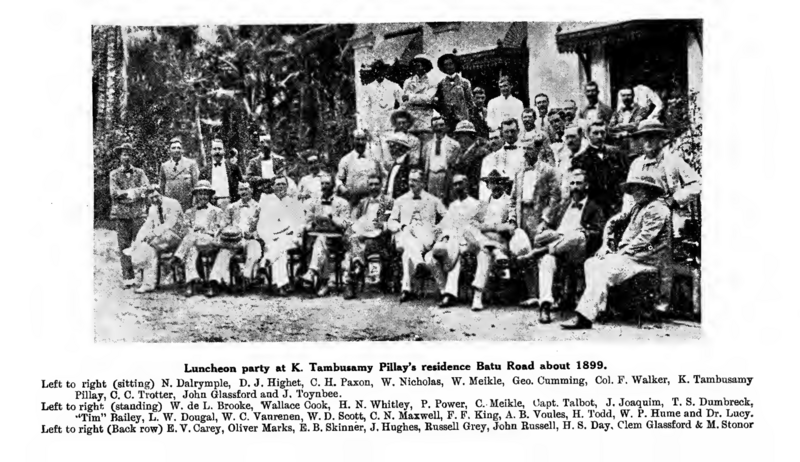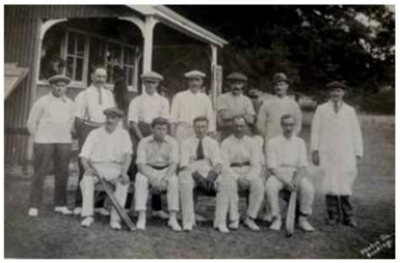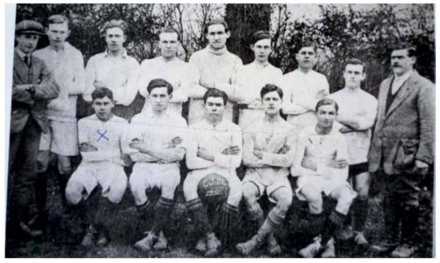Jadual Kandungan
Edmund Becher (E. B.) Skinner (1873-1959)
Dirujuk oleh
Perihal
Mr. E. B. Skinner merupakan tokoh pengusaha ladang getah yang tidak asing lagi di Selangor pada awal kurun ke-20. Antara lain, beliau adalah salah seorang pemilik serta pengurus West Country Estate, kini Bandar Baru Bangi: “Mr. E. B. Skinner, the general manager, is a son of Colonel Russell Skinner, and was born in 1873 at Muzzaffapur, India. He commenced planting in the Federated Malay States in 1891 and six years later took charge of the West Country estate. He is also the general manager and visiting agent of several other estates, and has interests in many properties.” (Arnold Wright, 1908: "Twentieth century impressions of British Malaya: its history, people, commerce, industries, and resources", m.s.465-467).
1873-1891: Kehidupan Awal
1873: Dilahirkan di Muzaffapur, India. Anak kepada Kolonel Russell Skinner: “Born in Mongafferpon, Bengal, India on 10 Nov 1873 to Russell Morland Skinner and Maria Josephine Dumergus. Edmund Becher SKINNER married Dorothy Frances Horsefall and had 3 children.” (Ancestry: |"Edmund Becher SKINNER (1873 - 1959) ").
1891: Mula bergiat dalam perladangan di Persekutuan Tanah Melayu.
1895: Batu Caves Estate
Sekitar tahun 1895, beliau menguruskan ladang kopi Batu Caves Estate: “E. B. Skinner at that time was in charge of Batu Caves estate.” (“RIMBA”, 1922: |"Bygone Selangor; a souvenir", m.s.38). Terdapat rekod pada 18/10/1895, beliau memohon penebangan hutan di kawasan ladang itu (PEJABAT SETIAUSAHA KERAJAAN NEGERI SELANGOR, 18/10/1895: |"Timber cutting on private land. Inquires whether or no Mr Birch's decision of 1892 holds good.").
LATAR PERISTIWA: Batu Caves Estate adalah antara ladang kopi terawal dibuka di Selangor (Kuala Lumpur) pada tahun 1890, selain Weld's Hill Estate: (Straits Times Weekly Issue, 3 June 1891, Page 13: |"Planting in Selangor in 1890").

Ladang kopi di Batu Caves Estate, Selangor, tahun 1899 (RBG KEW, 12th February 2015: |"Coffee harvest at Batu Cave Estate, Singapore, 1899").
1895-12-24: Permohonan Tanah di Kepong
Pada 24/12/1895, E.B. Skinner bersama beberapa rakan-rakan kongsi (A. Allen, F.B. Hicks, M.S. Parry) memohon beberapa bidang tanah seluas 500 ekar setiap seorang di Kepong (PEJABAT SETIAUSAHA KERAJAAN NEGERI SELANGOR, 24/12/1895: |"APPLICATIONS FOR LAND, 7? AND 10TH MILE ULU SELANGOR EXTENSION (MESSR. ALLEN, HICKS SKINNER & PARRY 500 ACRES EACH) 2. SALE OF LAND AT BATU (ON RAILWAYLINE) BY AUCTION").
Namun mereka membatalkannya sebulan kemudian pada 31/01/1896, sebelum memohon tanah-tanah di Rekoh (PEJABAT SETIAUSAHA KERAJAAN NEGERI SELANGOR, 31/01/1896: |"LAND IN KEPONG - WITHDRAWAL OF ALL APPLICATIONS FOR (MESSR. HICKS, ALLEN, PARRY AND SKINNER)").
Dalam lingkungan masa yang sama, E.B. Skinner meletakkan jawatan sebagai pengurus ladang Batu Caves Estate, untuk memfokus kepada ladang di Rekoh ini: “Mr E. B. Skinner will shortly relinquish charge of the Batu Caves Estate, as he is about to open up coffee in connection with Messrs. Hicks and Allen, two of he latest additions to our planting comm(u)nity.” (The Singapore Free Press and Mercantile Advertiser (Weekly), 21 January 1896, Page 4: |"SELANGOR NOTES").
1896-03: Pembukaan West Country Estate
Salah seorang rakan kongsi serta pengurus West Country Estate.
“Mr. E. B. Skinner, the general manager, is a son of Colonel Russell Skinner, and was born in 1873 at Muzzaffapur, India. He commenced planting in the Federated Malay States in 1891'and six years later took charge of the West Country estate. He is also the general manager and visiting agent of several other estates, and has interests in many properties.”
(Sumber: Arnold Wright, 1908: |"Twentieth century impressions of British Malaya: its history, people, commerce, industries, and resources", m.s.465-467).
LATAR PERISTIWA: West Country Estate.

Gambar di suatu majlis makan tengahari di kediaman K. Tambusamy Pillay di Batu Road, Kuala Lumpur, 1899. E. B. Skinner berdiri di belakang sekali, 3 dari kiri. (“RIMBA”, 1922: |"Bygone Selangor; a souvenir", m.s.42).
1908-10-13: Kelahiran Anak Kembar E.B. Skinner
Isteri E.B. Skinner melahirkan anak kembar, lelaki dan perempuan, di West Country Estate: “On the 13th inst. at West Country, Kajang, the wife of E.B.SKINNER of twin son and daughter.” (The Singapore Free Press and Mercantile Advertiser (Weekly), 22 October 1908, Page 1: |"Births").
1908-12-06: Ahli Jawatankuasa Imigrasi
Ahli jawatankuasa Imigrasi ketika itu, yang sedang mengusahakan kaedah alternatif atau kawalan kepada sistem sedia ada (kangani - sejenis sistem orang tengah) dalam perolehan serta pengurusan tenaga pekerja ladang dari India: “The powers of the Immigration Committee were discussed generally, and, in referring to the question of the recruiting allowance recently fixed, Mr. E.B. Skinner, of The West Country, Belmont and Aier Hitam Estates, Kajang, Selangor, a member of the Immigration Committee, stated that the object of the Immigration Commitee was to stop enormous advances being made, the tendency of recruiters in India being to demand higher rates than those usually allowed. It was agreed to ask the Immigration Commitee not to make any drastic financial changes affecting the interests of employers until the Association had had the opportunity of expressing an opinion on the matter.” (The Straits Times, 7 December 1908, Page 7: |"Malayan Planters.").
Perihal Jawatankuasa Imigrasi India:-
- “The Indian Immigration Fund was formed by the government to help overcome labour shortages in Malaya and it marked the beginning of 31 years of “assisted migration” from India to Malaya. The Tamil Immigration Fund Ordinance was approved in 1907, which led to establishment of Indian Immigration Committee (IIC) later it known as the Tamil Immigration Fund. The Committee brought together all the Departments of Indian Immigration in the Straits Settlements and the Federated Malay States for discussion on all matters pertaining to labour issues and the welfare of Indian labourers. The IIC consisted of British administration officials and unofficial members such as rubber plantation owners and community leaders. In 1907, the IIC established the Tamil Immigration Fund (TIF), sponsored by rubber plantation owners and the British government, to finance the cost of bringing Indian labourers to work on the estates in Malaya. This invariably established a state controlled structure for the mass recruitment of “free” South Indian labour. The fund provided free passage for Indian labourers intending to come in Malaya even though the recruiting of workers was carried out by licensed kangani with the approval of individual planters. All employers of Indian labour were charged a quarterly charge to cover the travel and related costs Indian labour immigrants to Malaya. The IIC was authorised to manage the movement of assisted labour migrants to Malaya by monitoring the number of recruiting licenses given to the kangani and also the recruiting allowance or subsidy to migrants. Crucially, this legislation resulted in Indian labour migration evolving into two distinct categories, namely recruited and nonrecruited migrants.” (Himanshu Prabha Ray, Susan Mishra @ ASEAN-India Centre at RIS, 2019: |"WORKING PAPER VII: INDIAN LEADERS IN MALAYSIA").
- “A notable development in labour policy was the establishment in 1907 of a centralised semi-official body, the Indian Immigration Committee (IIC), to facilitate and supervise South Indian labour recruitment. The IIC’s activities were strengthened in 1908 when, with the backing of employers, a Tamil Immigration Fund (the name was changed to the Indian Immigration Fund in 1910) was started to provide free passages for labourers to Malaya. All employers of Indian labour were charged a quarterly levy to cover the travel and related costs of free Indian labour migration to Malaya. This recruitment of voluntary workers was cheaper than the kangani system since intermediaries were bypassed, and additionally, the hold of the kangani over workers declined.” (Amarjit Kaur @ Modern Asian Studies 40, 2 (2006) pp. 425–475: |"Indian Labour, Labour Standards, and Workers' Health in Burma and Malaya, 1900–1940").
1910-1954: Tanjong Malim Rubber Company
Beliau turut terlibat dengan Tanjong Malim Rubber Company, dan kemudiannya dilantik menjadi pengerusinya. Beliau bersara pada Februari 1954: “After retirement, (H. H.) Facer became in February 1954 the chairman of the $500,000 Tanjong Malim Rubber Company succeeding E.B. Skinner who retired after a 44 year connection with the company.” (J. C. Rajarao, 2018: "The Malaysian Estates Staff Provident Fund 1947-2017: Malaysia's Oldest Provident Fund, with an Economic, Social and Political Perspective", m.s.186).
1911-05-01: Pengerusi Planters Association
Pada 1 Mei 1911, beliau dilantik sebagai pengerusi Planters' Association of Malaya (P.A.M.): “At the meeting of the Planters Association Mr E. B. Skinner was voted to the Chair. … As a result of the election of officers, Mr E. Macfadyen was elected Chairman but declined the appointment, and Mr Skinner was the elected Chariman and Mr C. St. G. Wheeley, Secretary.” (The Singapore Free Press and Mercantile Advertiser, 2 May 1911, Page 6: |"P. A. M.").
1912-04-11: Ahli Tidak Rasmi Majlis Persekutuan
Pada 11 April 1912, beliau dilantik sebagai salah seorang ahli tidak rasmi Majlis Mesyuarat Persekutuan Negeri-Negeri Melayu Bersekutu: “Downing Street, 11th April, 1912. The KING has been pleased to approve of the nomination of Edmund Becher Skinner, Esq., to be an Unofficial Member of the Federal Council of the Federated Malay States.” (|The London Gazette, 12 April 1912, m.s. 2638).
Beliau telah pun menghadiri beberapa siri mesyuarat sebelum pewartaan tersebut (Sumber: PEJABAT SETIAUSAHA KERAJAAN NEGERI SELANGOR @ Arkib Negara):-
1914-08-12: Bantahan Enakmen Kecemasan
Ketika suatu undang-undang khas Enakmen Kecemasan diperkenalkan oleh kerajaan British di Negeri-Negeri Melayu Bersekutu (NNMB) selepas Perang Dunia Pertama, E.B. Skinner ialah salah seorang ahli tidak rasmi Majlis Mesyuarat Persekutuan yang menyuarakan bantahan terhadap enakmen ini, oleh kerana ia memberikan kuasa berlebihan kepada Pesuruhjaya Tinggi NNMB. Namun ianya tetap diwartakan pada 12 Ogos 1914: “Sebelum tercetusnya Perang Dunia Pertama, British menerima baik kehadiran kuasa Eropah lain bagi kepentingan ekonomi di NNMB. Apatah lagi, pihak British membenarkan pelantikan konsul khas Jerman, Turki dan Austria-Hungary di NNMB demi menjaga kepentingan dan kebajikan warganegara mereka. Namun begitu, hubungan baik ini berubah selepas Perang Dunia Pertama meletus. Pihak British berasa sangsi dengan kehadiran kuasa asing di NNMB, lebih-lebih lagi yang terlibat dalam perang tersebut dengan menentang blok yang disertai oleh Britain. Pihak British kuasa-kuasa asing, khasnya yang bersekutu dengan Kuasa Pusat akan cuba campur tangan dan menggugat kedudukan mereka di NNMB. Oleh itu, bagi mengukuhkan penguasaan British di NNMB, sebuah undang-undang khas yang dikenali sebagai ‘The Public Emergency Enactment, 1914’ diwartakan dan dikuatkuasakan pada 12 Ogos 1914. Melalui enakmen ini, kuasa sepenuhnya diberikan kepada Pesuruhjaya Tinggi untuk menggubal atau meminda sebarang undang-undang bagi menjaga keselamatan dan pertahanan NNMB daripada kuasa musuh. Pesuruhjaya Tinggi juga diberikan kuasa untuk mengambil alih pentadbiran tanah, bahan makanan dan bahan api serta mengawal harga makanan dan arak. Sebelum diluluskan, undang-undang tersebut mendapat tentangan hebat semasa usul tersebut dibentangkan dalam Majlis Mesyuarat Persekutuan, khasnya daripada ahli tidak rasmi. Ahli tidak rasmi dilantik melalui syor Pesuruhjaya Tinggi untuk menganggotai Majlis Persekutuan. Ahli-ahli tidak rasmi seperti E.B. Skinner, W.F. Nutt, Eu Tong Sen dan Eric Macfadyen mempertikaikan tentang peranan dan kuasa Pesuruhjaya Tinggi dalam enakmen tersebut secara terang-terangan. Mereka menegaskan hanya Ketua Setiausaha Kerajaan sebagai ketua kerajaan di NNMB sepatutnya diberikan hak kuasa tersebut. Namun begitu, enakmen tersebut tetap diluluskan oleh kerajaan NNMB tanpa menghiraukan bantahan ahli-ahli tidak rasmi tersebut.” (Jayakumary Marimuthu @ Journal of History Department, University of Malaya; No. 30 (1), 2021: "KESAN PERANG DUNIA PERTAMA (1914-1918) TERHADAP NEGERI-NEGERI MELAYU BERSEKUTU (NNMB)", m.s. 64)
1914-11-03: Bantahan Peruntukan Kerja Raya
Pada 3 November 1914, kerajaan British telah mengurangkan belanjawan perkhidmatan kerja raya di Negeri_negeri melayu Bersekutu (NNMB) dengan drastik (dari 13 juta kepada 1.5 juta ringgit). E.B. Skinner adalah salah seorang ahli tidak rasmi Majlis Mesyuarat Persekutuan yang membantah keputusan ini, dengan hujah bahawa 80% buruh bakal kehilangan kerja: “Keadaan kewangan kerajaan NNMB yang jelas merosot akibat perang tersebut disifatkan sebagai tidak mampu menandingi kedudukan kewangan kerajaan NNS (Negeri-Negeri Selat) yang dilihat lebih stabil. … Ekoran itu, pihak kerajaan mengambil beberapa langkah untuk mengimbangkan semula kedudukan kewangan kerajaan. Antaranya ialah, pada persidangan Majlis Mesyuarat Persekutuan yang berlangsung pada 3 November 1914, kerajaan telah merancang sebuah belanjawan yang lebih ketat bagi tahun 1915 dengan mengurangkan kos beberapa jabatan. Sebagai contohnya, bajet bagi pejabat Ketua Setiausaha dan Residen dikurangkan sebanyak $1,000; Jabatan Bendahari, $2,000; Pejabat Daerah dan Pejabat Tanah, $ 3,500; Mahkamah, $4,000; Jabatan Perdagangan dan Kastam, $15,000, Jabatan Perlombongan, $ 2,000; Jabatan Pendidikan tidak lebih daripada $9,000 dan Jabatan Kesihatan, $49,000.34 Cadangan ini telah menimbulkan rasa tidak puas hati dalam kalangan anggota Majlis Persekutuan. Antaranya ialah E.B. Skinner, ahli tidak rasmi tidak bersetuju dengan pengurangan peruntukan bagi Perkhidmatan Kerja Raya daripada $13,000,000 pada tahun 1914 kepada $1,500,000 sahaja pada tahun 1915. Bagi beliau, pengurangan ini hanya akan menyebabkan hampir 80 % buruh kehilangan kerja.” (Jayakumary Marimuthu @ Journal of History Department, University of Malaya; No. 30 (1), 2021: "KESAN PERANG DUNIA PERTAMA (1914-1918) TERHADAP NEGERI-NEGERI MELAYU BERSEKUTU (NNMB)", m.s. 67).
1920-an: Socfin
Sekitar 1920-an, beliau dikatakan mempunyai saham yang besar di dalam suatu syarikat perladangan warga Belgium, Société Financière des Caoutchoucs, yang kemudiannya berkembang menjadi Socfin Group kini: “E. B. and R. M. Skinner are still largely connected with rubber planting interests and held a large share in the big Belgian Company, but their interests were recently changed, and they still remain large sharedholders and Directors only of the Kajang Group, of which “West Country” is the chief one. They have interests in Kedah and elsewhere also. It is believed that both brothers had retired, but the big slump in the rubber industry when the price went below seven pence has caused a good few old planters to return and reorganise their large interests.” (“RIMBA”, 1922: |"Bygone Selangor; a souvenir", m.s.40).
1930-1940an: Pengarah Syarikat-Syarikat Perladangan
Sekitar 1930-an hingga 1940-an, beliau adalah pengarah beberapa syarikat perladangan di Selangor, antaranya:-
- Buloh River Rubber Estates: “Presiding at the annual meeting of the Buloh River Rubber states, Ltd., on Feb. 18, Mr. E. B. Skinner said that the past year had been particularly difficult owing to continued and acute depression in the rubber market.” (The Straits Times, 19 March 1931, Page 5: |"BULOH RIVER RUBBER.").
- Junun Rubber Estates: “Mr. E. B. Skinner (chairman) presided, and in moving the adoption of the report, said that while the crop for 1932 was under 1 per cent.” (Malaya Tribune, 29 May 1933, Page 5: |"JUNUN RUBBER ESTATES").
- Tambira Rubber Estates: “Mr. E.B. Skinner, the chairman, who presided, said that they had sustained a trading loss for the year of £4,050, comparing with £6,408 in 1931.” (Malaya Tribune, 29 May 1933, Page 5: |"TAMBIRA RUBBER").
- Tamiang Rubber Estates: “Annuaire Desfossés, 1937, p. 1381 + 1940, p. 1907 : Tamiang Rubber. Conseil d'administration : Sir Herbert Wright, pdt ; E.-B. Skinner, C.H. Wright, H. Harold F. Copeman. …. Annuaire Desfossés, 1948, p. 2257 : Tamiang Rubber. Conseil d'administration : E.-B. Skinner, pdt ; C.H. Wright, H. Harold F. Copeman, J.W.A. Calver.” (Alain LÉGER @ Les entreprises coloniales françaises: Comptoirs français de l'Inde INDOCHINE: Indes néelandaises, Malaisie, Siam, 2020: |"Tamiang Rubber Estates").m.s.5)
- Kuala Lumpur Rubber Estates:-
- “KUALA LUMPUR (RUBBER Cy, LTD.) (Malaisie) [187]. Conseil : MM. Everard Feilding, Arthur Acland Allen, Alfred Grisar, John Gurdon, Methold Sidney, Parry J. R., Edmund Becher Skinner.” (Alain LÉGER @ Les entreprises coloniales françaises: Comptoirs français de l'Inde INDOCHINE: Indes néelandaises, Malaisie, Siam, 2020: |"Leroy (Marcel), Le Caoutchouc (1935) : notices sur 26 sociétés d'Indochine, 22 du Sud-Est asiatique, 2 d'Afique noire").m.s.132)
- “Mr. E.B. Skinner, chairman, presided at the annual general meeting of Kuala Lumpur Rubber Company in London on Dec. 14.” (The Straits Times, 24 December 1937, Page 18: |"REPLANTING BY KUALA LUMPUR RUBBER CO.").
- “Unsettled conditions in Malaya are delaying an extensive programme of replanting by the Kuala Lumpur Rubber Company, the Chairman (Mr. E. B. Skinner) told stockholders at their 42nd annual meeting.” (The Straits Times, 3 January 1949, Page 6: |"Replanting Delayed").
1959-04-20: Meninggal Dunia
Beliau meninggal dunia pada 20 April 1959 di England: “He passed away on 20 Apr 1959 in England.” (Ancestry: |"Edmund Becher SKINNER (1873 - 1959)").
Pengakuan penting: Kami bukan ahli sejarah! Sila klik di sini untuk penjelasan lanjut.
Peninggalan
Skinner Drive
E.B. Skinner tinggal agak lama di Toutley Hall, Emmbrook, Wokingham, England. Beliau banyak menyumbang kepada masyarakat setempat, sehingga nama beliau diabadikan pada salah satu jalan di sana: “Edmund Becher SKINNER lived at Toutley Hall (in what is now Old Forest Road) in the first half of the twentieth century. He was recorded as a Lieutenant with the Royal Garrison Artillery 1914-22 and later had been General Manager or Chairman of various Rubber Companies. It was during his time at Toutley Hall before the Second World War that anybody who had fallen ill in the village of Emmbrook was offered fruit and vegetables from the garden there. Some years on a Sunday he opened the gardens to the public (admission 6d {2½p}) in aid of the Queen’s Institute of District Nursing. Before the war he was President of “Embrook Cricket Club” and in 1957 he was elected Life President of what was then “Embrook Sports Club”. While still living in Wokingham in 1949 he gave the Sports Ground at Lowther Road to Wokingham Borough Council by Deed with a restrictive Covenant that it be used only for amateur sports and recreational purposes. He died in 1959 at the age of 85 years.” (Emmbrook Residents Association: |"Emmbrook Place Street Names").


Gambar pasukan yang pernah memanfaatkan pusat aktiviti sukan yang dianugerahi oleh E.B. Skinner: “Edmund Skinner gave the sports ground at Lowther Road to Wokingham Borough Council in 1949, adding a covenant that it can only be used for physical training and recreation. Teams using it included the Emmbrook cricket team in the 1920s (left) and the football team of 1919 (right).” (The Wokingham Paper, Apr 22, 2016, m.s.20: "Murded in Emmbrook - the peculiar case of Charles Forester").
Pengakuan penting: Kami bukan ahli sejarah! Sila klik di sini untuk penjelasan lanjut.
